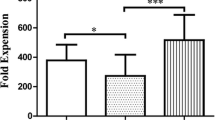Abstract
Effects of a streptococcal preparation, OK-432, on precursors of lymphokine-activated killer (LAK) cells were observedin vivo. Total number of splenocytes and the ratio of asGM +1 cells increased gradually after i.v. administration of OK-432, reaching their peaks at 3 to 4 days. It was found that as GM +1 cells were nonadherent and large in size. There were little differences in the ratios of Thy-1+, Lyt-2+, and L3T4+ cells before and after OK-432 treatment. Mice were injected i.p. with recombinant interleukin 2 (rIL-2) at a dose of 5 × 104 U per mouse 4 days after OK-432 administration and LAK activity in their splenocytes was examined using natural killer (NK) resistant EL-4 target cells. Splenocytes in mice treated with both OK-432 and rIL-2 showed higher LAK activity than those in mice treated with rIL-2 alone.In vivo treatment with anti asGM, antibody prior to rIL-2 injection abolished completely such augmentation of LAK activity in OK-432 treated mice. These results demonstrated that asGM +1 LAK precursor cells induced by OK-432 were effectively differentiated into LAK cells by rIL-2.
Similar content being viewed by others
References
Grimm EA, Mazumder A, Zhang HZ, Rosenberg SA. Lymphokine-activated killer cell phenomenon. Lysis of natural killer-resistant fresh solid tumor cells by interleukin 2-activated autologous human peripheral blood lymphocytes. J Exp Med 1982; 155: 1823–41.
Rosenberg SA. Lymphokine-activated killer cells: A new approach to immunotherapy of cancer. J Natl Cancer Inst 1985; 75: 595–601.
Lafreniere R, Rosenberg SA. Successful immunotherapy of murine experimental hepatic metastases with lymphokine-activated killer cells and recombinant interleukin 2. Cancer Res 1985; 45: 3735–40.
Mazumder A, Rosenberg SA. Successful immunotherapy of natural killer-resistant established pulmonary melanoma metastases by the intravenous adoptive transfer of syngeneic lymphocytes activatedin vitro by interleukin 2. J Exp Med 1984; 159: 495–507.
Mule J, Shu S, Schwarz SL, Rosenberg SA. Adoptive immunotherapy of established pulmonary metastases with LAK cells and recombinant interleukin-2. Science 1984; 225: 1487–9.
Lotze MT, Matory YL, Ettinghausen SE, Rayner AA, Sharrow SO, Seipp CAY, Custer MC, Rosenberg SA.In vivo administration of purified human interleukin 2. II. Half life, immunologic effects, and expansion of peripheral lymphoid cellsin vivo with recombinant IL 2. J Immunol 1985; 135: 2865–75.
Tanida S, Uchida H, Taniguchi K, Nomoto K. Marked reduction of subcutaneous tumor growth by intraperitoneal administration of recombinant human interleukin-2 with a cell accumulator, proteose-peptone, in mice. Cancer Res 1989; 49: 284–8.
Hoshino T, Uchida A, Iho S, Kura F, Takahashi T. Immunopharmacological aspect of OK-432 in the treatment of malignant diseases with a special reference to an induction of autologous tumor killing activity. In Host defense mechanisms and immunopotentiators. Tokyo: Chugai pharmaceutical Co. Ltd., 1986 5–11.
Micksche M, Cichoka-Furlinger B, Uchida A, Vinzenz K, Kokoschka E, Nowotny C, Dittrich C, Sagaster P, Luger TA. Clinical studies with OK-432 in cancer patients. In: Micksche M. & Klein E. Eds. OK-432, a biological response modifier. Tokyo: Professional Postgraduate Services, 1986 1–6.
Pollack SB. OK-432 stimulates primary production and activity of murine natural killer cells. Nat Immun Cell Growth Regul 1987; 6: 224–36.
Piguet P, Grau G, Irle C, Vassalli P. Administration of recombinant interleukin 2 to mice enhances production of hemopoietic and natural killer cells. Eur J Immunol 1986; 16: 1257–61.
Owen-Schaub LB, Abraham SR, Hemstreet III GP. Phenotypic characterization of murine lymphokine-activated killer cells. Cell Immunol 1986; 103: 272–86.
Suzuki R, Handa K, Rob K, Kumagai K. Natural killer (NK) cells as a responder to interleukin 2 (IL2). I. Proliferative response and establishment of cloned cells. J Immunol 1983; 130: 981–7.
Itoh K, Tilden AB, Kumagai K, Balch CM. Leu-11+ lymphocytes with natural killer (NK) activity are precursors of recombinant interleukin 2 (rIL 2)-induced activated killer (AK) cells. J Immunol 1985; 134: 802–7.
Lotze MT, Matory YL, Rayner AA, Ettinghausen SE, Vetto JT, Seipp CA, Rosenberg SA. Clinical effects and toxicity of interleukin-2 in patients with cancer. Cancer 1986; 58: 2764–72.
Mule J, Yang JC, Afreniere RL, Shu S, Rosenberg SA. Identification of cellular mechanisms operationalin vivo during the regression of established pulmonary metastases by the systemic administration of high-dose recombinant interleukin 2. J Immunol 1987; 139: 285–94.
Koo GC, Manyak CL. Generation of cytotoxic cells from murine bone marrow by human recombinant IL 2. J Immunol 1986; 137: 1751–6.
Ting C, Yang SS, Hargrove ME. Lymphokine-induced cytotoxicity: characterization of effectors, precursors, and regulatory ancillary cells. Cancer Res 1986; 46: 513–8.
Damle NK, Doyle LV, Bradley EC. Interleukin 2 activated human killer cells are derived from phenotypically heterogeneous precursors. J Immunol 1986; 137: 281–422.
Saito M, Ichimura O, Kataoka M, Moriya Y, Ueno K, Sugawara Y, Nanjo M, Ishida N. Pronounced antitumor effect of LAK-like cells induced in th peritoneal cavity of mice after intraperitoneal injection of OK-432, a killed Strepto-coccal preparation. Cancer Immunol Immunother 1986; 22: 161–8.
Crump III WL, Owen-Schaub LB, Grimm EA. Synergy of human recombinant interleukin 1 with interleukin 2 in the generation of lymphokine-activated killer cells. Cancer Res 1989; 49: 149–53.
Yagita M, Grimm EA. Inhibition of in vitro LAK generation by OK-432. Cancer Immunol Immunother 1986; 23: 207–13.
Toki H, Kimura Y, Okabe K, Fujii M, Tamai M. Pharmacokinetics and lymphocyte blastogenesis in response to mitogens in cancer patients treated with OK-432 by various administration route. In: Hoshino T ed. Immunopharmacological aspects of OK-432 in humans. Tokyo: Excerpta Medica, 1986: 124–32.
Author information
Authors and Affiliations
Rights and permissions
About this article
Cite this article
Shimoda, K., Saito, T., Kobayashi, M. et al. Effectivein vivo induction of lymphokine-activated killer (LAK) cells by pretreatment with a streptococcal preparation, OK-432. Biotherapy 5, 63–69 (1992). https://doi.org/10.1007/BF02194786
Received:
Accepted:
Issue Date:
DOI: https://doi.org/10.1007/BF02194786




